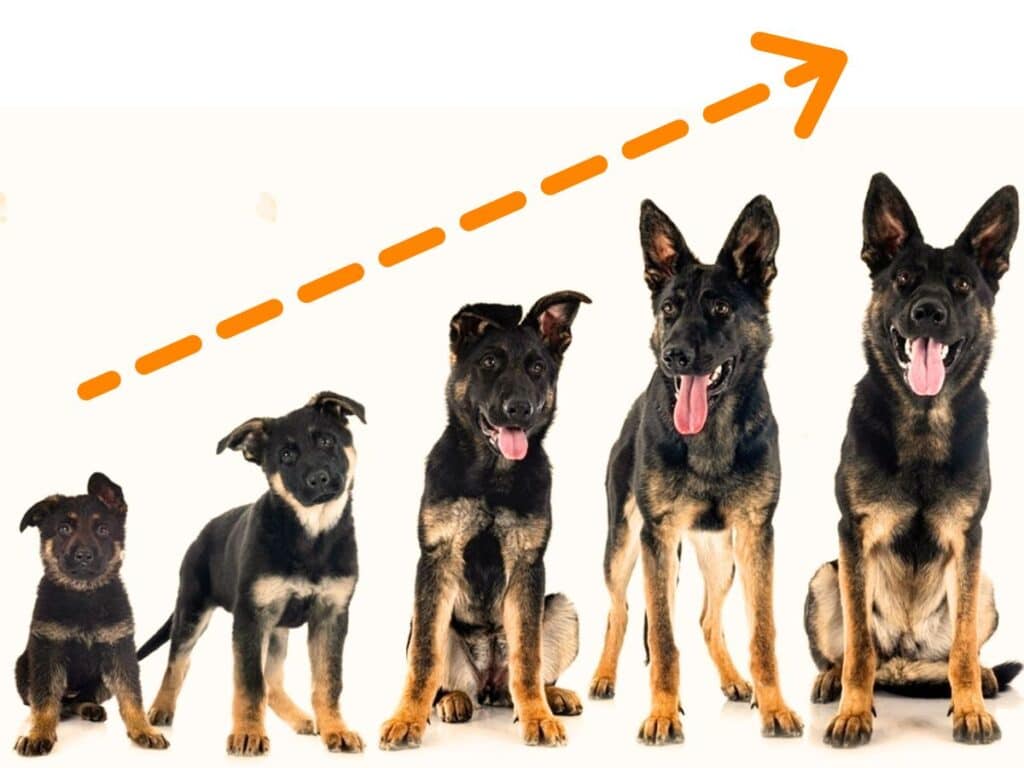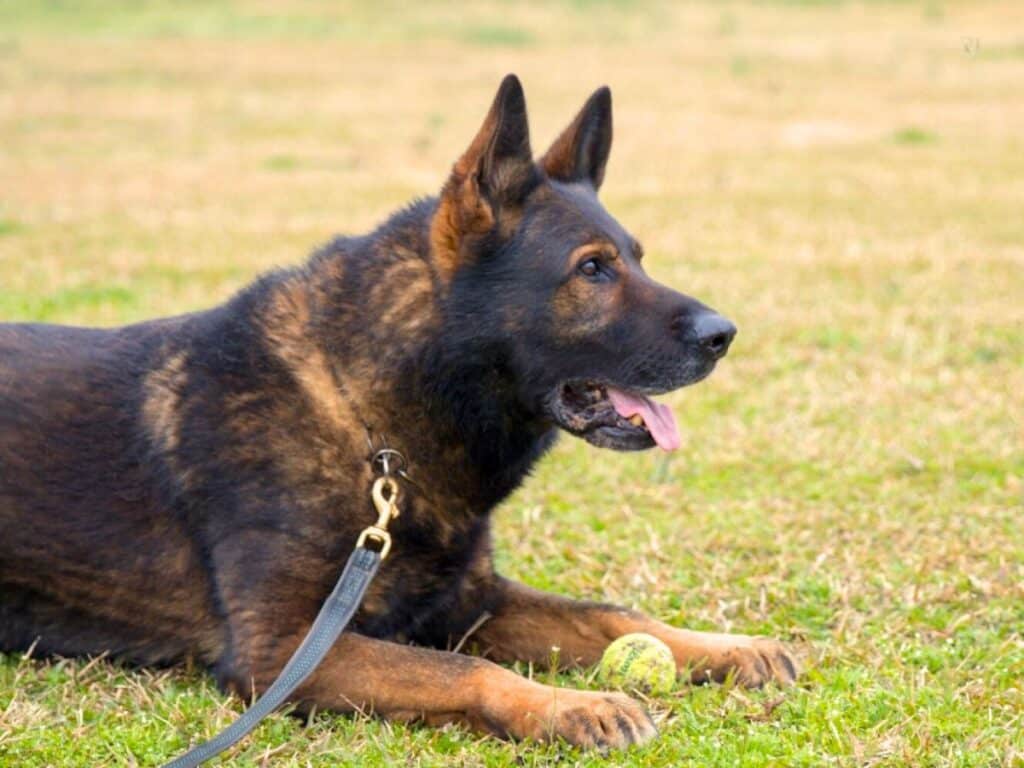Are you a proud owner of a new German Shepherd puppy? Are you curious about how much your furry friend will grow and weigh as they mature?
If so, you’ve come to the right place! In this article, we’ll cover everything you need to know about German Shepherd growth & weight charts.
By understanding the typical milestones associated with this majestic breed’s growth chart, you’ll be better equipped to ensure that your furry friend thrives throughout their life.
According to AKC, The German Shepherd breed standard for fully grown male is typically between 24-26 inches tall at the shoulder and weighing between 65-90 pounds.
For adult female German Shepherds, the standard height is between 22-24 inches tall at the shoulder, and weighing between 50-70 pounds.
German Shepherd Growth & Weight Chart
A German Shepherd growth and weight chart can help track the development of a puppy and ensure they are growing at a healthy rate.
However, it’s important to keep in mind that every puppy is unique, and growth rates can vary based on genetics, nutrition, exercise, and other factors.
Here is a general male & female German Shepherd growth and weight chart:

Stages of German Shepherd Puppy Development
Neonatal Period: Birth – 3 Weeks Old GSD Puppies

From birth until they are three weeks old, German Shepherd puppies enter the neonatal period.
During this stage, GSD puppies are completely dependent on their mother for food and warmth.
The mother’s milk provides essential nutrients and antibodies that help protect the puppies from infections.
Because the puppies are so dependent on their mother during this time period, it is essential that she is healthy and well-fed.
This period is characterized by rapid physical development and sensory exploration, as well as vulnerability to various health risks.
GSD puppies are born with their eyes and ears closed, and they rely on their sense of smell to locate their mother and littermates.
During the first two weeks, they will rapidly gain weight and double their birth weight.
At around two weeks, their eyes and ears will open, and they will start to explore their surroundings.
While German Shepherd puppies are still very young during the neonatal period, they begin to develop social bonds with their littermates and mother.
Related Articles
- 1 Month-Old German Shepherd: Everything You Need To Know
- 6 Week Old German Shepherd: A Guide for New Puppy Parents
- 7 Week Old German Shepherd: What You Need to Know
- 5 Week Old German Shepherd Puppy Care Guide
8-Week-Old (2 Months) German Shepherd

At two months old, a German Shepherd puppy has entered the socialization period and is becoming more active and playful.
At two months old, a male puppy typically weighs between 16 to 20 pounds and stands around 7 to 9 inches tall at the shoulder.
Female German shepherd puppies are generally slightly smaller, weighing between 11 to 17 pounds and standing 6 to 9 inches tall.
At this age, they are energetic, playful, and curious. They enjoy exploring their environment and interacting with their owners and other animals.
At two months old need plenty of exercise and playtime to burn off their excess energy.
Moreover, are ready to begin basic obedience training.
Simple commands such as “sit,” “stay,” and “come” can be taught using positive reinforcement techniques such as treats and praise.
German Shepherd puppies should receive their first vaccination from a veterinarian at 6 to 8 weeks of age.
This initial shot is typically the DHLPCC vaccine, which protects against Distemper, Adenovirus type 2, Leptospirosis, Parainfluenza, Parvovirus, and Coronavirus.
Related Article
- 2 Month-Old German Shepherd: What To Expect
- 9 Week Old German Shepherd: Everything You Need To Know
- How to Care for a 10-Week-Old German Shepherd Puppy
Check out this selection of handpicked essentials for your German Shepherd on my Amazon store – Click Here!
3-month-old German Shepherd
At 3 months old, a German Shepherd puppy should weigh between 22 to 30 pounds and stand around 9-11 inches tall.
At three months old, a puppy is still learning about the world around them.
They may start to bark or growl to express themselves.
They also have a stronger desire to explore their surroundings and may become more curious about unfamiliar objects.
Puppies at this age may also start to display signs of teething, such as chewing on objects.
At 18 weeks old, they are ready to continue their basic obedience training and can start learning more complex commands.
RELATED:
- 3 Month Old German Shepherd: How to Ensure a Healthy & Happy Pup
- 14 Week Old German Shepherd: Size, Nutrition & More
4-month-old German Shepherd

At 4 months old, a male GSP pup should weigh between 35-40 pounds, while females should weigh between 31-35 pounds.
The height of a male German Shepherd at this age should be around 11-14 inches, while female German Shepherd pups should be around 10-12 inches.
During this stage of development, German Shepherds are still growing rapidly and may experience some awkwardness in their movements as they adjust to their changing bodies.
Their back legs may appear longer than their front legs, but this is normal and will eventually even out as they reach full size.
At this point in their puppyhood, they are full of energy and require plenty of exercise to support their physical development.
Daily walks or runs in the park can help keep them active and healthy.
Mental stimulation is also crucial for their cognitive development – playing games such as hide-and-seek or practicing obedience training can provide the necessary mental challenge.
It’s important to establish yourself as the alpha in your relationship with your dog early on to prevent any dominance issues down the line.
This means setting boundaries and rules for your dog to follow consistently.
This is also the time for your puppy to get his/her DHPP and Rabies vaccinations.
Related Article
- 4 Month Old German Shepherd: Everything You Need To Know
- What You Must Know About Female German Shepherds
5-month-old German Shepherd

At five months old, a puppy is continuing to grow and develop both physically and mentally.
The average height for a five-month-old male German Shepherd is around 14-16 inches, while females are slightly smaller at 12-14 inches.
On average, a male pup weighs between 40-49 pounds at this age while female german shepherd puppies weigh between 35-44 pounds.
Five-month-old German Shepherd puppies are becoming more confident and independent.
They may start to challenge authority and push boundaries to test their limits. They may also become more protective of their family and property.
Puppies at this age may also display more aggression towards other dogs.
Socialization is crucial during this stage to ensure that they develop good behavior habits early on.
At this time in their puppyhood, they enjoy running, jumping, and playing and may be more interested in games of fetch or frisbee.
As intelligent animals, they need mental stimulation through interactive toys like puzzle feeders or treat-dispensing toys to prevent boredom from setting in.
Related Article
6-month-old German Shepherd

At six months, a German Shepherd puppy has reached the halfway point to adulthood.
While they still have a lot of growing to do, this is an important stage in their development that requires close monitoring.
Typically, at this age, a male German Shepherd weighs between 49-57 pounds and stands around 16-18 inches tall at the shoulder.
Female German Shepherds, on the other hand, weigh between 44-49 pounds and stand around 15-17 inches tall.
At this point, puppies are becoming more confident, independent, and self-assured.
They may start to display more protective behaviors and may become more wary of strangers.
At six months old, your puppy will have bursts of energy followed by periods of rest throughout the day.
German Shepherd puppies at six months old have a lot of energy and require plenty of exercise and playtime to stay healthy and happy.
They enjoy running, jumping, and playing and may be more interested in longer walks or hikes.
Related Article
7-month-old German Shepherd
At seven months old, your pup is likely still growing in both height and weight.
You can expect your puppy to continue growing until they reach their full size at around two years old.
In terms of behavior, your puppy may start exhibiting more independence as they become more confident in themselves.
They may display more stubbornness and become more headstrong as they continue to test boundaries and establish their place in the family hierarchy.
Related Article
8-month-old German Shepherd

Now your puppy is starting to develop into a young adult, both physically and mentally.
An 8-month-old male German shepherd weighs anywhere from 62-66 pounds, while females typically weigh between 53-57 pounds.
Their height at this age can range from 18-20” for females and 20 – 22” for males.
They may start to display more maturity and focus.
They may become more patient and attentive during training sessions, and their desire to please their owners may become more evident.
Puppies at this age may also become more affectionate with their family members, showing more loyalty and devotion.
German Shepherds at eight months old may start to show more of their individual personality traits.
Some may be more outgoing and sociable, while others may be more reserved or cautious.
Related Article
9-month-old German Shepherd
Nine-month-old German Shepherds may continue to show more maturity and focus in their behavior.
They may become more confident in their abilities and may be more willing to take on new challenges.
Puppies at this age may also become more vocal, expressing their needs and desires through barking, whining, or growling.
Personality: German Shepherds at nine months old may start to display more of their adult personality traits.
Some may be more dominant and assertive, while others may be more laid-back and easygoing.
Puppies at this age may also show more of their protective instincts, becoming more watchful and alert to their surroundings.
Related Article
10-month-old German Shepherd

At ten months old, your German Shepherd is well on their way to becoming an adult dog.
A male at this point weighs 66 – 73 lbs. and stands between 22 – 24” tall, while a female weighs between 57 – 62 lbs and typically measures around 19 – 21” in height.
By this point, they should be close to their full-grown size and weight, although some dogs may continue to grow for another few months.
German Shepherds at ten months old are still active and energetic but may start to show more self-control and restraint.
They may continue to display their protective instincts and may become more territorial.
Puppies at this age may also start to experience a second fear period, which means they may become more fearful or reactive to certain stimuli.
At ten months old, a German Shepherd’s personality is mostly formed, and its individual temperament may become more apparent.
RELATED: 10 Month Old German Shepherd: Complete Care Guide
11-month-old German Shepherd
At eleven months old, your doggy is still considered a puppy but is nearing their first birthday.
At eleven months old are still very active and energetic. They may start to become more independent and may be more inclined to explore their environment.
They may also become more territorial and protective of their family and home. Puppies at this age may also start to test boundaries and may require consistent discipline.
12-month-old (1 year) German Shepherd
As a German Shepherd owner, you may be wondering what to expect when your furry friend reaches 12 months old.
Now your puppy is considered an adult and has gone through a significant amount of growth and development since their birth.
At this age, male doggies should weigh between 71 – 79 lbs and reach a height of around 22-24 inches at the shoulder.
Females, on the other hand, weigh between 60 – 64 lbs and measure around 20-22 inches in height.
At one year old, many German Shepherds have completed their growth spurt but may continue to develop muscle mass through regular exercise.
At this point, your puppy has typically calmed down from their puppy phase but is still energetic and active.
They are intelligent and eager to learn, making them highly trainable.
They may also become more protective of their family and may display some guarding behaviors.
Proper socialization and training of your German shepherd are important at this age to prevent aggressive or fearful behaviors from developing.
Also, this is when your pup needs to get his/her DHPP and Rabies vaccinations again.
RELATED: German Shepherd Price: Total Cost of Buying & Maintaining a GSD
18-month-old German Shepherd

At 18 months old, your pup has reached its full size and is likely to be more muscular and physically fit than they were at 12 months old.
At this age, they are typically more settled and calm than they were during their puppy phase.
They still have plenty of energy, but they have learned to channel it in a more focused and controlled way.
They are likely to have developed strong bonds with their family and maybe protective of them.
Proper socialization and continued training are important to ensure they remain well-behaved and obedient.
They may also have a strong prey drive and enjoy activities such as playing fetch or tracking.
Factors Affecting Growth and Weight of German Shepherd Puppy
Genetics: The Foundation of Growth and Weight
The growth and weight of a puppy are largely determined by genetics.
Puppies inherit their size and weight from their parents, so it is important to choose a reputable breeder who focuses on producing healthy puppies with desirable traits.
It is also essential to know the breed standard for German Shepherds, which sets guidelines for height, weight, and overall appearance.
Nutrition: Fueling Healthy Growth
Proper nutrition is crucial for the growth and development of a German Shepherd puppy.
Puppies require a diet that is high in protein, fat, vitamins, and minerals to support their rapid growth.
Feeding them a well-balanced diet that meets their nutritional needs will help ensure they reach their full potential in terms of size and weight.
Affect of Neutering/Spaying on GSD Puppy’s Growth
Neutering or spaying a German Shepherd puppy can potentially affect its growth. (Source)
When a puppy is neutered or spayed, their sex hormones are removed, which can impact their growth and development.
In particular, the growth plates in the bones may close at a later age, leading to delayed growth and potential joint problems later in life.
However, the extent of this impact can vary depending on the age at which the puppy is neutered or spayed.
If a German Shepherd puppy is neutered or spayed before they reach sexual maturity (around 6-9 months of age), the impact on its growth may be less noticeable.
On the other hand, if a puppy is neutered or spayed later in life after they have reached sexual maturity, there may be a greater risk of delayed growth and joint problems.
It’s important to consult with a vet to determine the best time to neuter or spay a German Shepherd puppy based on their individual health and growth needs.
Physical Health
Regular vet checkups are essential for maintaining the physical health of your puppy. Any underlying health issues can impact your puppy’s growth and development.
Additionally, exercise plays an important role in keeping your puppy healthy both physically and mentally.
When do German Shepherds stop growing?

German Shepherds typically stop growing when they are between 18 – 24 months old, although some may continue to grow slowly until they are 3 years old.
However, their weight may continue to increase until they reach 3 years old, especially in larger males.
It’s important to note that growth rate and final size can vary depending on genetic factors, nutrition, and other environmental factors.
Proper nutrition, exercise, and vet care are essential to support a German Shepherd’s growth and development.
It’s important not to overfeed your puppy during growth spurts – too much weight gain can put undue stress on developing bones and joints.
A balanced diet with appropriate amounts of protein, fat, carbohydrates, vitamins, and minerals is essential for proper growth.
As your puppy grows into an adult dog, you’ll notice changes in their behavior as well – they may become calmer or less excitable than when they were younger.
Also, please remember that every dog is unique – some may mature faster or slower than others.
Older Dogs: Maintaining Health

As your German Shepherd ages past two years old into middle age (around six to eight years old) and beyond, it’s important to keep up with regular vet check-ups and preventative care.
This includes vaccinations, dental cleanings, bloodwork, and parasite prevention.
You may also need to adjust their diet as they become less active or develop health issues like arthritis.
It’s important to maintain a healthy weight to avoid putting extra stress on joints and organs.
Older dogs may also experience changes in behavior or cognitive function – they may become more anxious or confused than when they were younger.
Providing plenty of mental stimulation through puzzles, games, and training can help keep their minds sharp.
What is the size of a full-grown German shepherd?
The size of a full-grown German Shepherd varies depending on their gender and lineage.
On average, male German Shepherds stand between 24 to 26 inches (60 to 65 cm) tall at the shoulder and weigh between 65 to 90 pounds (30 to 40 kg).
Females are slightly smaller, standing between 22 to 24 inches (55 to 60 cm) tall at the shoulder and weighing between 50 to 70 pounds (23 to 32 kg).
However, some larger or smaller variations can occur within the breed.
It’s important to note that genetics, nutrition, and exercise can all play a role in a German Shepherd’s size and weight.
RELATED: Why is My German Shepherd So Small?
Average Adult German Shepherd Weight
Evaluating Your German Shepherd’s Weight
To evaluate your German Shepherd’s weight, you can use a body condition score chart.
This chart allows you to assess your dog’s overall appearance, including the shape of its ribs, spine, and waistline.
However, it’s important to keep in mind that each dog is unique and may require different amounts of food and exercise.
What If My German Shepherd Is Overweight?
If your doggy weighs more than it should, it’s essential to take action immediately.
Obesity can lead to several health problems such as joint pain, heart disease, and diabetes.
One way to address this problem is by adjusting their diet.
You may need to switch them over to low-fat dog food or reduce the amount of food they consume daily.
Another solution is regular exercise. As highly active dogs, GSDs require physical activity such as walks or playtime with toys.
Regular exercise not only helps them maintain a healthy weight but also prevents destructive behavior caused by boredom.
Click here to learn more about diabetes mellitus in German Shepherds.
What If My German Shepherd Is Underweight?
On the other hand, if your doggy weighs less than they should, it could indicate an underlying health issue or malnutrition.
In this case, it’s best to consult with a veterinarian who can provide guidance on how to help your dog gain weight in a healthy way.
One solution might be switching them over to higher calorie foods such as puppy chow or adding supplements like omega-3 fatty acids that promote healthy weight gain.
Dangers of Growing Too Quickly or Stunted Growth

Proper Growth and Development in German Shepherds
Proper growth and development are crucial for the health and well-being of your German Shepherd.
Stunted or accelerated growth can lead to a variety of health problems, including joint pain, mobility issues, hip dysplasia, and other serious health conditions.
As such, it’s important to understand the many factors that can impact your dog’s growth and take steps to ensure they grow up healthy and strong.
Growth Spurts & Plateaus
German Shepherds go through several growth spurts during their first year of life. These are periods when they experience rapid growth in height, weight, and muscle mass.
While these spurts are normal, it’s important to monitor your dog’s progress closely during this time to ensure they’re growing at a healthy rate.
During these growth spurts, you may notice that your dog seems hungrier than usual.
This is because their body needs more nutrients to support their growing muscles and bones.
To accommodate this increased need for nutrition, you may need to adjust your dog’s diet accordingly.
Growth Plates
One of the most important things to keep in mind when it comes to proper growth in German Shepherds is the role of growth plates.
These are areas of cartilage at the ends of bones that allow them to grow longer as your dog develops.
If a puppy experiences stunted or accelerated growth during this time, it can cause damage to its growth plates that may result in permanent deformities or other health issues later on in life.
As such, it’s crucial to provide proper care during this stage of development by ensuring your puppy gets enough exercise but not too much strain on their joints.
Growth Distinctions of Different Types of German Shepherds

There are several different types of GSDs, and each may have slight differences in their growth patterns. Here are some growth distinctions:
American Show Line German Shepherds
These dogs are bred primarily for their looks and conformation to breed standards.
They are typically larger than other types of German Shepherds, with males weighing between 75 to 95 pounds (34 to 43 kg) and females weighing between 60 to 80 pounds (27 to 36 kg).
They typically have a more sloping back than other types of German Shepherds, which can put them at risk for hip and joint problems.
West German Show Line German Shepherds
West German Show Line German Shepherds are also bred for their looks and conformation to breed standards, but they tend to have a more balanced body structure than American Show Line German Shepherds.
They are typically slightly smaller than American Show Line German Shepherds, with males weighing between 66 to 88 pounds (30 to 40 kg) and females weighing between 49 to 71 pounds (22 to 32 kg).
East German DDR German Shepherds
East German DDR German Shepherds were originally bred as working dogs and tend to be more muscular and athletic than their show-line counterparts.
They typically have a straighter back, which can reduce their risk of hip and joint problems.
They are typically larger than West German Show Line German Shepherds, with males weighing between 77 to 99 pounds (35 to 45 kg) and females weighing between 55 to 77 pounds (25 to 35 kg).
Czech shepherds
Czech Shepherds are also bred as working dogs and tend to be smaller and more agile than other types of German Shepherds.
They typically have a straighter back but are not as heavily muscled as DDR Shepherds.
They are typically smaller than West German Show Line German Shepherds, with males weighing between 55 to 77 pounds (25 to 35 kg) and females weighing between 44 to 66 pounds (20 to 30 kg).
It’s important to note that these size and growth distinctions are generalizations, and there can be variation within each type of German Shepherd.
RELATED: Difference Between Working Line and Show Line German Shepherds
Conclusion
Understanding the growth and weight chart of German Shepherds is crucial for responsible dog ownership and ensuring the well-being of these magnificent companions.
Throughout their various life stages, German Shepherds experience rapid growth and significant weight gain, which can vary from individual to individual.
By consulting a reliable growth chart and working closely with a veterinarian, owners can track their German Shepherd’s development, identify potential health issues, and provide appropriate care and nutrition.
FURTHER READING:




